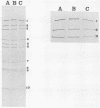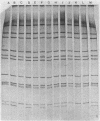Abstract
The occurrence of genome segment reassortment between two antigenically related orbiviruses was demonstrated in cattle. Individual virus clones were isolated by cell culture plaque assays directly from the blood of a calf infected with two serotypes of bluetongue virus. The majority (89%) of progeny viruses isolated from the calf represented reassortant viruses. A minimum of six genome segments participated in reassortment, with 16 unique reassortant constellations being identified. Such genome segment reassortment between unique, though antigenically related, orbiviruses has undoubtedly played a major role in generating the extensive phenotypic and genotypic diversity that is characteristic of this serogroup.
Full text
PDF
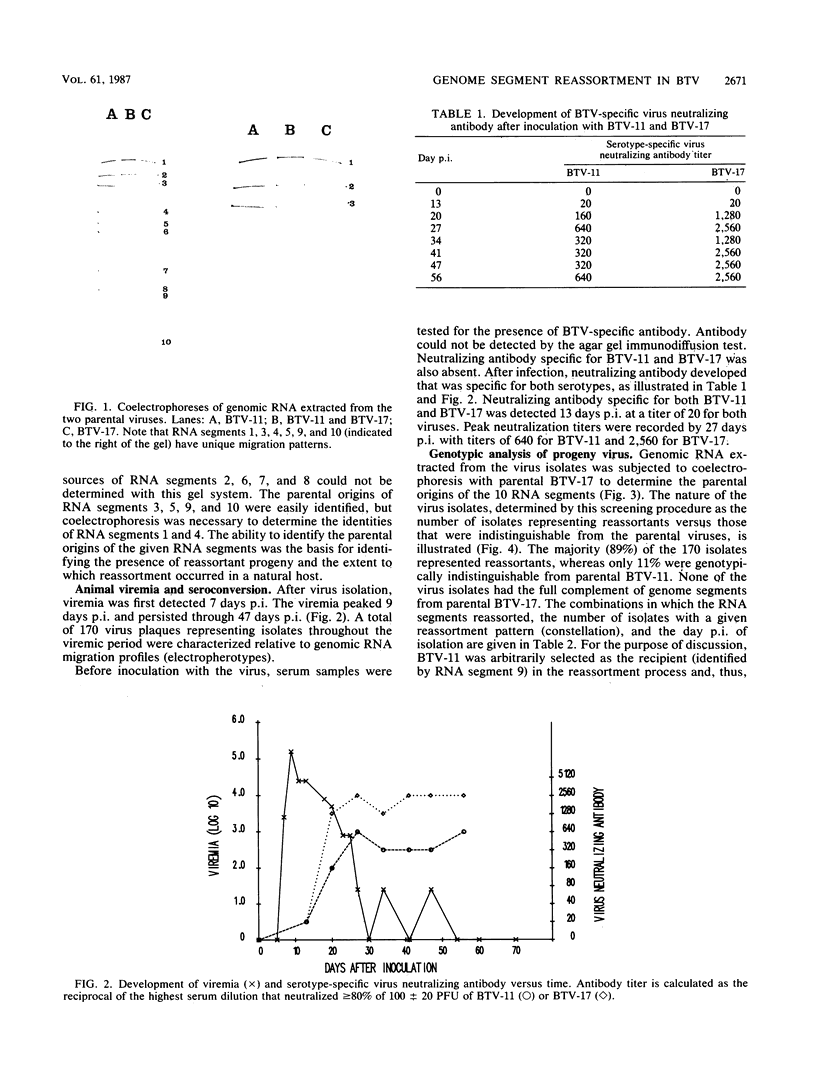
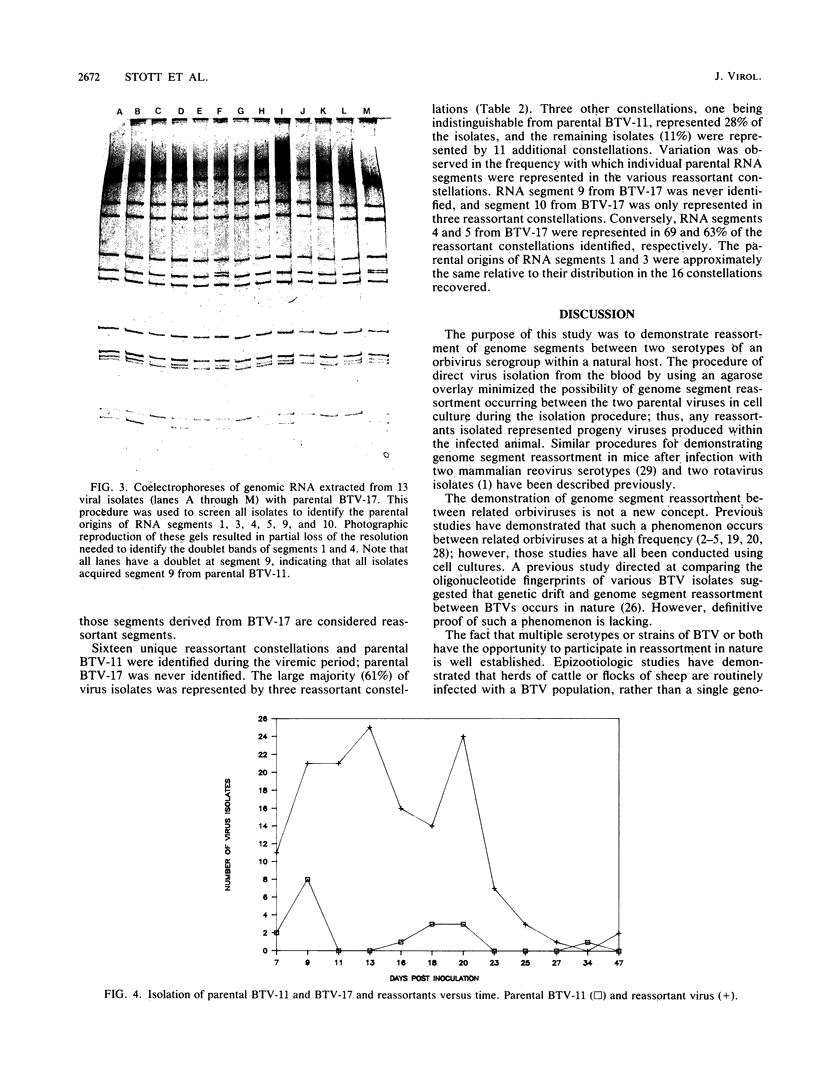
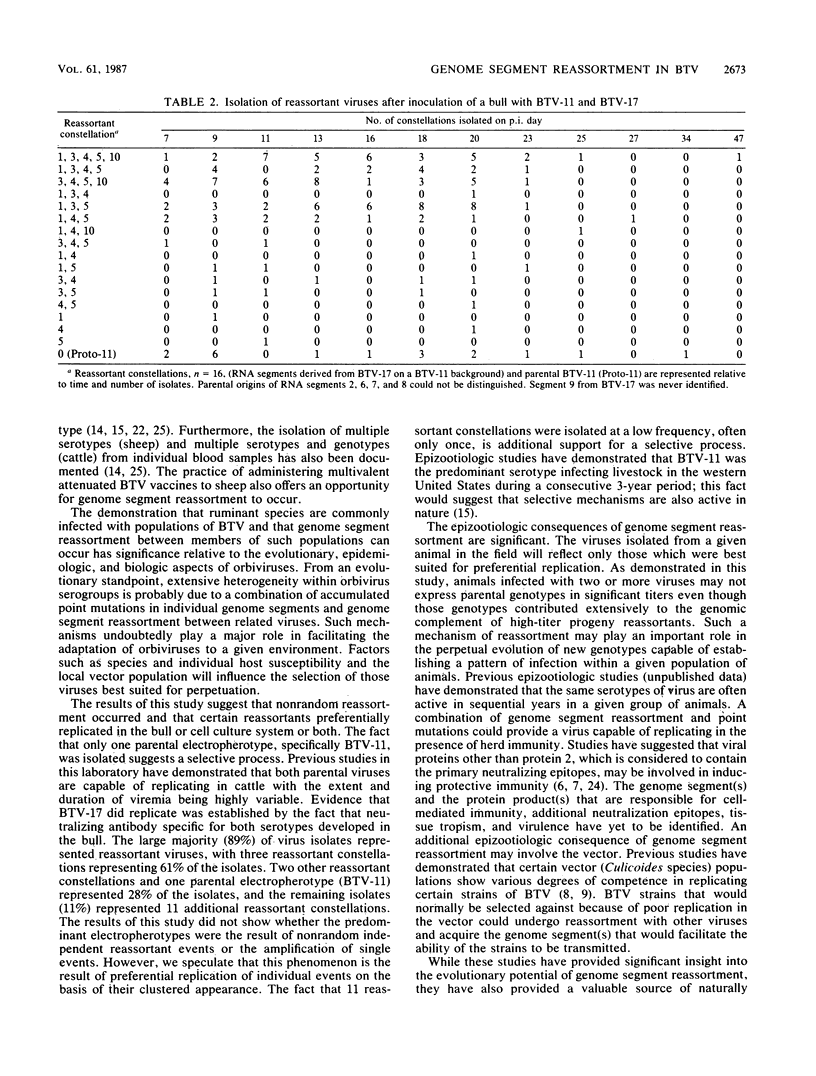
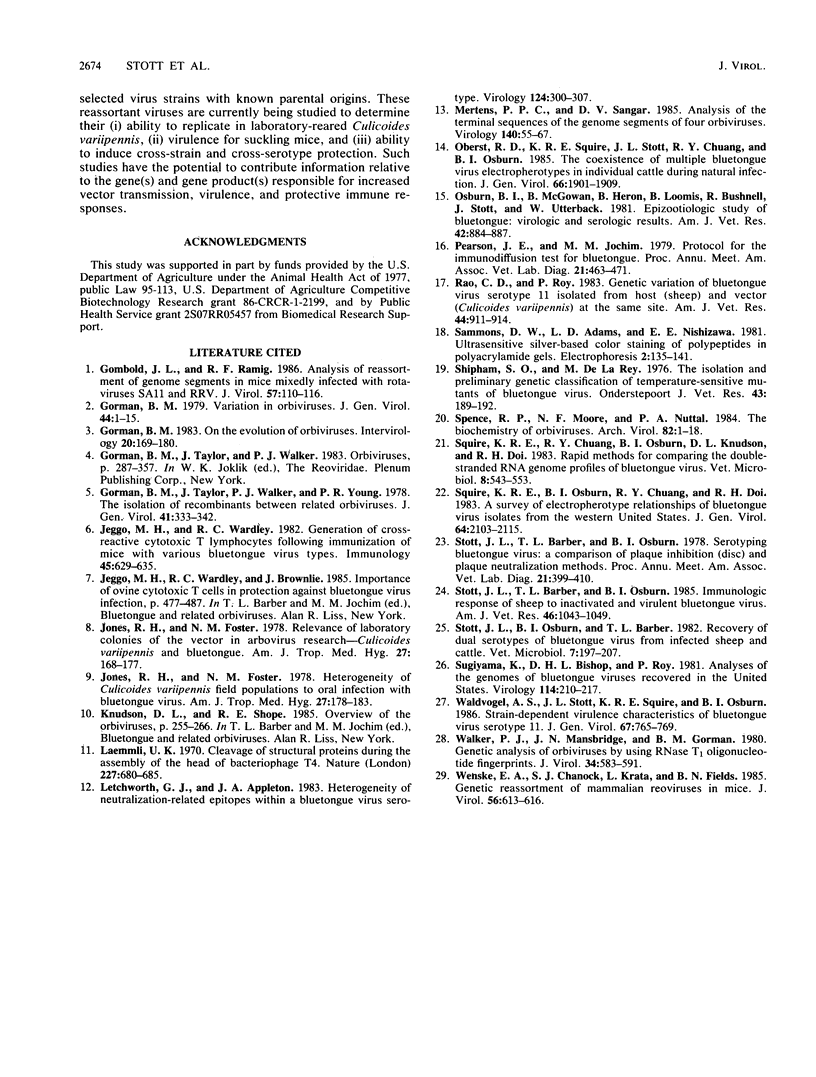
Images in this article
Selected References
These references are in PubMed. This may not be the complete list of references from this article.
- Gombold J. L., Ramig R. F. Analysis of reassortment of genome segments in mice mixedly infected with rotaviruses SA11 and RRV. J Virol. 1986 Jan;57(1):110–116. doi: 10.1128/jvi.57.1.110-116.1986. [DOI] [PMC free article] [PubMed] [Google Scholar]
- Gorman B. M. On the evolution of orbiviruses. Intervirology. 1983;20(2-3):169–180. doi: 10.1159/000149388. [DOI] [PubMed] [Google Scholar]
- Gorman B. M., Taylor J., Walker P. J., Young P. R. The isolation of recombinants between related orbiviruses. J Gen Virol. 1978 Nov;41(2):333–342. doi: 10.1099/0022-1317-41-2-333. [DOI] [PubMed] [Google Scholar]
- Gorman B. M. Variation in orbiviruses. J Gen Virol. 1979 Jul;44(1):1–15. doi: 10.1099/0022-1317-44-1-1. [DOI] [PubMed] [Google Scholar]
- Jeggo M. H., Wardley R. C., Brownlie J. Importance of ovine cytotoxic T cells in protection against bluetongue virus infection. Prog Clin Biol Res. 1985;178:477–487. [PubMed] [Google Scholar]
- Jeggo M. H., Wardley R. C. Generation of cross-reactive cytotoxic T lymphocytes following immunization of mice with various bluetongue virus types. Immunology. 1982 Apr;45(4):629–635. [PMC free article] [PubMed] [Google Scholar]
- Jones R. H., Foster N. M. Heterogeneity of Culicoides variipennis field populations to oral infection with bluetongue virus. Am J Trop Med Hyg. 1978 Jan;27(1 Pt 1):178–183. doi: 10.4269/ajtmh.1978.27.178. [DOI] [PubMed] [Google Scholar]
- Jones R. H., Foster N. M. Relevance of laboratory colonies of the vector in arbovirus research--Culicoides variipennis and bluetongue. Am J Trop Med Hyg. 1978 Jan;27(1 Pt 1):168–177. doi: 10.4269/ajtmh.1978.27.168. [DOI] [PubMed] [Google Scholar]
- Knudson D. L., Shope R. E. Overview of the orbiviruses. Prog Clin Biol Res. 1985;178:255–266. [PubMed] [Google Scholar]
- Laemmli U. K. Cleavage of structural proteins during the assembly of the head of bacteriophage T4. Nature. 1970 Aug 15;227(5259):680–685. doi: 10.1038/227680a0. [DOI] [PubMed] [Google Scholar]
- Letchworth G. J., Appleton J. A. Heterogeneity of neutralization-related epitopes within a bluetongue virus serotype. Virology. 1983 Jan 30;124(2):300–307. doi: 10.1016/0042-6822(83)90346-x. [DOI] [PubMed] [Google Scholar]
- Mertens P. P., Sangar D. V. Analysis of the terminal sequences of the genome segments of four orbiviruses. Virology. 1985 Jan 15;140(1):55–67. doi: 10.1016/0042-6822(85)90445-3. [DOI] [PubMed] [Google Scholar]
- Oberst R. D., Squire K. R., Stott J. L., Chuang R. Y., Osburn B. I. The coexistence of multiple bluetongue virus electropherotypes in individual cattle during natural infection. J Gen Virol. 1985 Sep;66(Pt 9):1901–1909. doi: 10.1099/0022-1317-66-9-1901. [DOI] [PubMed] [Google Scholar]
- Osburn B. I., McGowan B., Heron B., Loomis E., Bushnell R., Stott J., Utterback W. Epizootiologic study of bluetongue: virologic and serologic results. Am J Vet Res. 1981 May;42(5):884–887. [PubMed] [Google Scholar]
- Rao C. D., Roy P. Genetic variation of bluetongue virus serotype 11 isolated from host (sheep) and vector (Culicoides variipennis) at the same site. Am J Vet Res. 1983 May;44(5):911–914. [PubMed] [Google Scholar]
- Shipham S. O., de la Rey M. The isolation and preliminary genetic classification of temperature-sensitive mutants of bluetongue virus. Onderstepoort J Vet Res. 1976 Dec;43(4):189–192. [PubMed] [Google Scholar]
- Spence R. P., Moore N. F., Nuttall P. A. The biochemistry of orbiviruses. Brief review. Arch Virol. 1984;82(1-2):1–18. doi: 10.1007/BF01309364. [DOI] [PubMed] [Google Scholar]
- Squire K. R., Chuang R. Y., Osburn B. I., Knudson D. L., Doi R. H. Rapid methods for comparing the double-stranded RNA genome profiles of bluetongue virus. Vet Microbiol. 1983 Nov;8(6):543–553. doi: 10.1016/0378-1135(83)90003-2. [DOI] [PubMed] [Google Scholar]
- Squire K. R., Osburn B. I., Chuang R. Y., Doi R. H. A survey of electropherotype relationships of bluetongue virus isolates from the western United States. J Gen Virol. 1983 Oct;64(Pt 10):2103–2115. doi: 10.1099/0022-1317-64-10-2103. [DOI] [PubMed] [Google Scholar]
- Stott J. L., Barber T. L., Osburn B. I. Immunologic response of sheep to inactivated and virulent bluetongue virus. Am J Vet Res. 1985 May;46(5):1043–1049. [PubMed] [Google Scholar]
- Stott J. L., Osburn B. I., Barber T. L. Recovery of dual serotypes of bluetongue virus from infected sheep and cattle. Vet Microbiol. 1982 Jul;7(3):197–207. doi: 10.1016/0378-1135(82)90034-7. [DOI] [PubMed] [Google Scholar]
- Sugiyama K., Bishop D. H., Roy P. Analyses of the genomes of bluetongue viruses recovered in the United States. I. Oligonucleotide fingerprint studies that indicate the existence of naturally occurring reassortant BTV isolates. Virology. 1981 Oct 15;114(1):210–217. doi: 10.1016/0042-6822(81)90266-x. [DOI] [PubMed] [Google Scholar]
- Waldvogel A. S., Stott J. L., Squire K. R., Osburn B. I. Strain-dependent virulence characteristics of bluetongue virus serotype 11. J Gen Virol. 1986 Apr;67(Pt 4):765–769. doi: 10.1099/0022-1317-67-4-765. [DOI] [PubMed] [Google Scholar]
- Walker P. J., Mansbridge J. N., Gorman B. M. Genetic Analysis of Orbiviruses by Using RNase T(1) Oligonucleotide Fingerprints. J Virol. 1980 Jun;34(3):583–591. doi: 10.1128/jvi.34.3.583-591.1980. [DOI] [PMC free article] [PubMed] [Google Scholar]
- Wenske E. A., Chanock S. J., Krata L., Fields B. N. Genetic reassortment of mammalian reoviruses in mice. J Virol. 1985 Nov;56(2):613–616. doi: 10.1128/jvi.56.2.613-616.1985. [DOI] [PMC free article] [PubMed] [Google Scholar]



